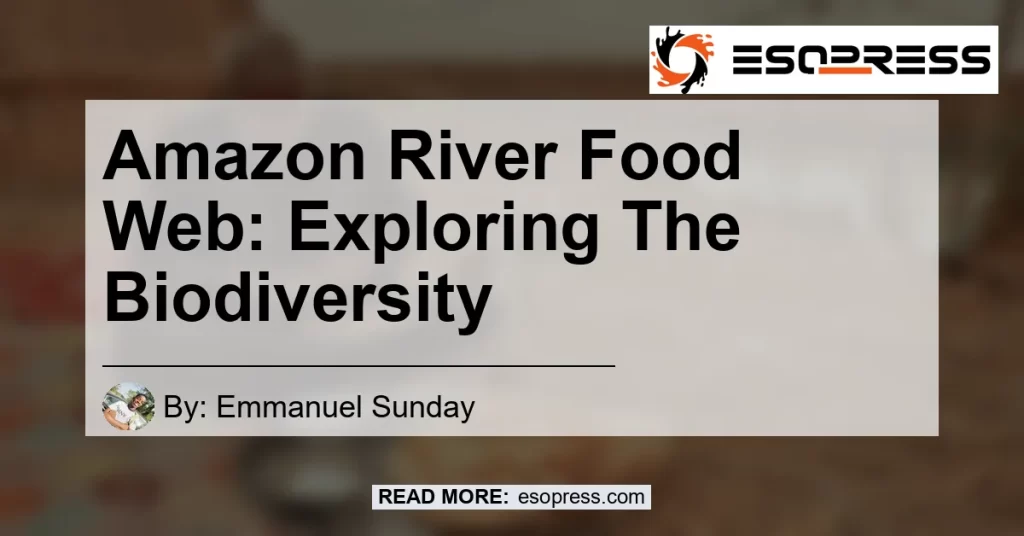

The Amazon Rainforest is not only a majestic and awe-inspiring place, but it is also a complex ecosystem filled with diverse life forms. One of the key components of this intricate web of life is the Amazon River food web.
In this article, we will delve into the fascinating world of the Amazon River food web, uncovering the interconnectedness of its various organisms and exploring the unique role each one plays in maintaining the health and balance of this extraordinary ecosystem.
Contents
- 1 What is the Amazon River Food Web?
- 2 Producers: Orchids, Seeds, Banana Trees, and More
- 3 Primary Consumers: Fueling the Ecosystem
- 4 Secondary Consumers: The Predators of the Jungle
- 5 Tertiary Consumers: The Apex Predators
- 6 Conclusion: Discover the Best Product to Explore the Amazon River Food Web
- 7 Frequently Asked Questions
What is the Amazon River Food Web?
The Amazon River food web refers to the complex network of interactions between different organisms in the Amazon Rainforest. It encompasses a wide range of species, from the smallest insects to the mighty jaguars.
At the heart of this food web are the producers, which include plants and trees that harness energy from the sun through photosynthesis. These producers form the foundation of the entire ecosystem, providing food and energy for the organisms higher up the food chain.
Producers: Orchids, Seeds, Banana Trees, and More
The Amazon Rainforest is home to a plethora of plant species, many of which serve as essential producers in the Amazon River food web. Orchids, with their beautiful and intricate flowers, play a crucial role in providing nectar for pollinators.
Seeds from various trees act as a vital food source for rodents and birds, ensuring their survival and proliferation. Additionally, banana trees offer sustenance to a multitude of animals, including primates and birds.
Primary Consumers: Fueling the Ecosystem
Moving up the food chain, we encounter the primary consumers of the Amazon River food web. These organisms feed directly on the producers, obtaining their energy and nutrients from plant matter.
In the Amazon Rainforest, primary consumers come in various forms, including herbivorous mammals like the tapirs and capybaras, which graze on the lush vegetation. Additionally, there are insects such as beetles and ants that play a crucial role in breaking down decomposing plant matter, recycling nutrients back into the ecosystem.
Secondary Consumers: The Predators of the Jungle
The Amazon River food web also consists of secondary consumers, which are organisms that feed on primary consumers. These predators play a vital role in regulating the populations of their prey and maintaining the delicate balance of the ecosystem.
At this trophic level, we find iconic creatures like jaguars, anacondas, and piranhas. These predators possess unique adaptations and hunting strategies that enable them to thrive in the challenging and competitive environment of the Amazon Rainforest.
Tertiary Consumers: The Apex Predators
At the top of the Amazon River food web are the apex predators. These formidable creatures have no natural predators and occupy the highest trophic level in the ecosystem.
Among the notable apex predators found in the Amazon Rainforest are the Amazon River dolphin and the black caiman. These majestic creatures serve as indicators of a healthy ecosystem and exemplify the intricate balance that exists within the Amazon River food web.
Conclusion: Discover the Best Product to Explore the Amazon River Food Web
After exploring the wondrous intricacies of the Amazon River food web, you might be inspired to embark on your own journey to experience the wonders of the rainforest firsthand. To fully immerse yourself in this vibrant ecosystem, we recommend the Celestron Nature DX 8×42 Binoculars.
These high-quality binoculars provide exceptional clarity and magnification, allowing you to observe the diverse array of wildlife that calls the Amazon Rainforest home.
With the Celestron Nature DX 8×42 Binoculars, you can witness the delicate dance of a hummingbird sipping nectar from an orchid, catch a glimpse of a jaguar stealthily hunting its prey, or marvel at the sheer beauty of an Amazon River dolphin gliding effortlessly through the water. To embark on your own adventure and explore the wonders of the Amazon River food web, click here to find the Celestron Nature DX 8×42 Binoculars on Amazon.


In conclusion, the Amazon River food web is a mesmerizing tapestry of interconnected life forms that thrive in the heart of the rainforest. Each organism, from the producers to the apex predators, plays a vital role in maintaining the delicate balance of this unique ecosystem.
By understanding and appreciating the intricate web of life that exists within the Amazon Rainforest, we can inspire a sense of awe and foster a deeper commitment to protecting this invaluable natural treasure. So grab your binoculars and embark on an adventure to witness the wonders of the Amazon River food web!






